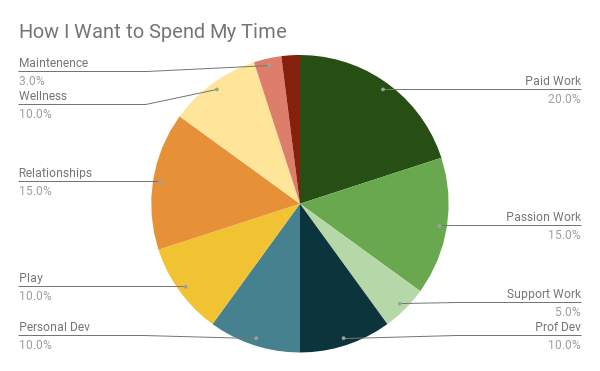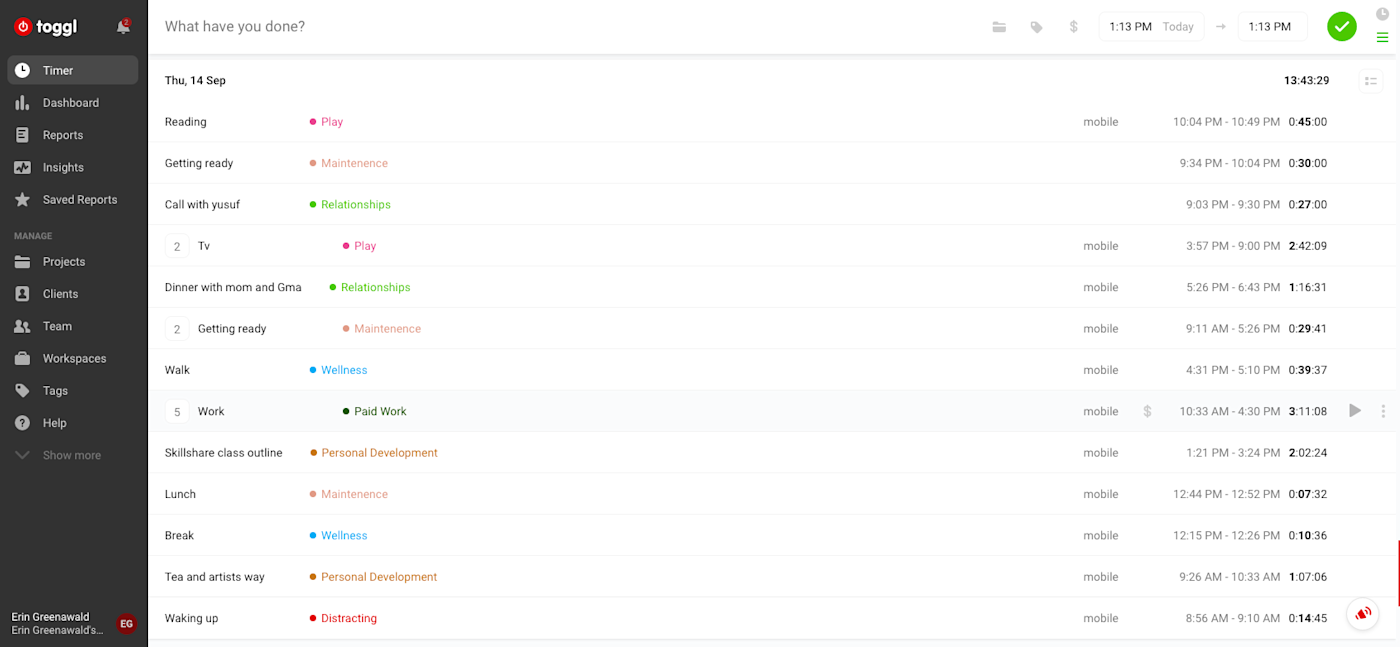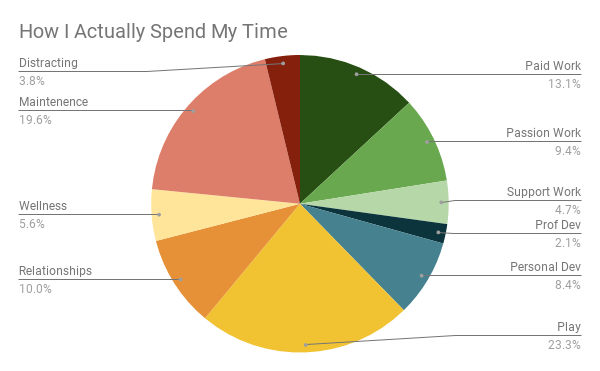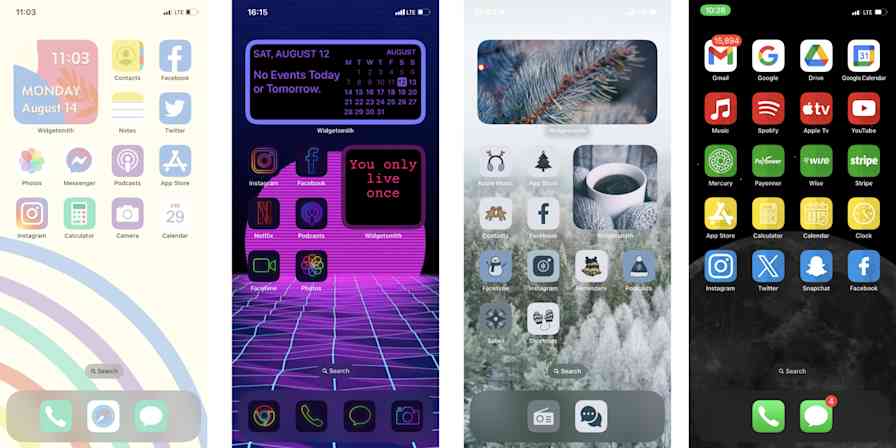"How we spend our days is of course how we spend our lives," wrote author Annie Dillard. "What we do with this hour and that one is what we are doing."
No matter what you think your priorities are, what you actually devote your time to is what you’re choosing to make a priority in your life. But how many people really know how they spend every minute or their days?
We actually have a lot of minutes every day—1,440 of them to be specific. Even accounting for a healthy eight hours of sleep, that’s nearly 1,000 minutes to fill with everything you want to do. And yet, I often get to the end of the day and feel like I didn’t have enough time for everything that mattered. Something must be taking more time than it deserves, and I wanted to figure out what so I could stop wasting time and make every day more meaningful.
So, I decided to track every moment of my time for a month and find out how my idea of how I spent my time matched up with reality. Here’s how I did it, what I learned, and why you might want to do it, too. (Spoiler alert: Like tracking your budget to manage your finances or your daily calorie intake to manage your diet, tracking your time can help you manage your most precious resource.)
Step 1: Choose Your Time Categories
Over the course of the month, I’d track over 43,000 minutes. I needed to come up with some general categories of where my time went in order to be able to label each time entry and make that data meaningful.
So, I thought about my life and the areas where I wanted to devote time to. After some brainstorming, I landed on the following eight categories:
Paid work (e.g., freelance clients)
Passion work (e.g., side projects)
Professional development (e.g., business development, networking, job applications)
Personal development (e.g., journaling, classes or workshops, inspiring reading)
Relationships (e.g., spending time with family, phone calls with friends, dates)
Play (e.g., shopping, TV, casual reading, going out)
Wellness (e.g., working out, taking necessary breaks, self care)
Support work (e.g., volunteering, mentoring)
I also had to get real and create a couple categories for areas I knew some of my time went to, even if I wasn’t thrilled about that fact. These included:
Distractions (e.g., flipping through social media mindlessly, taking extra time to get out of bed in the morning)
Maintenance (e.g., running errands, getting ready, doing chores)
While I tracked sleep to make sure I accurately kept up with 24 hours in a day, I didn't include it in my analysis because I know it accounts for about a third of my time and don’t want to change that. If cutting back on sleep to make room for other things interests you, it might be worth tracking here, too. I decided to focus just on how I spend my waking hours.
Most of these categories probably apply to everyone, but yours may be a little different. Do your best to come up with areas you think your time goes to—or want it to go to, even if you’re not actually focusing on them that right now. Try to keep it to around 10 categories so you don’t get overwhelmed with options.
Step 2: Determine Your Ideal Allocation of Time
While I wanted to do my best to not judge how I was spending my time during the experiment—to just track it as it is and analyze at the end—I did want to have a baseline to compare my results to. This wasn't a hypothesis of how I spend my time, but more of a vision for how I would like my time to be allocated.

When doing this exercise, think about how many hours in a week you want to spend doing something and figure out a percentage from there. The reason a week might be more meaningful than a day is that things can differ a lot day to day—weekends are different from weekday, for example—but are usually pretty normalized week over week.
Let yourself be aspirational here and really imagine how you want to "spend your life," but also be realistic. If you work a 9-to-5 job and don’t plan on changing that anytime soon, then paid work will need to account for about 40 hours of your weeks or about 36% of your waking time.
Editor's note: You can apply this strategy to get a clearer breakdown of where your time goes at work, too. Just adjust the categories to break the workday into types of tasks.
Editor's note: You can apply this strategy to get a clearer breakdown of where your time goes at work, too. Just adjust the categories to break the workday into types of tasks.
Step 3: Set Up Your Tools
Next, you’ll need to set up the tools you use to track your time. I decided to use time tracking app Toggl because I already use it for tracking work. Plus, they have an iPhone app so I could track every minute on the go (as well as an Android app along with Chrome and Firefox extensions). I created a project for each of my time categories so I could easily label each activity.

There are lots of other ways you could do this as well. If you’re used to another time tracking software, use that. You could add your time tracking to Google Calendar as events throughout the day, and use app automation tool Zapier to save those events to a Google Sheets spreadsheet that you can analyze later. You could have RescueTime automatically track your time in apps and on websites and, if you opt for the premium plan, track offline activities and keep a daily log of your accomplishments.
Here are a few ways you can automate the time tracking with popular apps:
Create a RescueTime highlight when a Trello card is moved
Create detailed Google Calendar events for new Toggl Track time entries
Create Google Sheets rows for every new time entry in Toggl Track
Need a new time tracking app? Check our list of the best time tracking apps to compare their features and find the best one for you.
Step 4: Start Tracking!
Now it’s time to get going! Pick a morning to start as soon as you wake up, put a reminder on your calendar to stop tracking time 4 weeks from that day, and start recording your time.
The first thing I noticed when I started tracking was a lot of resistance. It’s so hard to remember to do this, it takes more time to track everything than it’s worth, I thought. Spoiler alert: I’m glad I pushed through this initial resistance and tracked the whole time as I learned some interesting things.
That said, it was very easy to forget I was supposed to be tracking my time, especially in the first week or so of doing it. After a day or so of continuously forgetting, I set periodic reminders on my phone to notify me throughout the day. I also decided I would check in at the end of every day to make sure I had accounted for my whole day.
The other thing I immediately noticed was how hard it is to categorize certain swaths of time.
Sometimes it was because I felt like I was doing multiple things in one activity. Take cooking: Cooking seems like a maintenance activity, but it’s also something I enjoy doing, so I could see it as wellness at the end of a long day and, if I’m cooking with someone else, that could also be considered nurturing for my relationships.
Other times, it was because I couldn’t really put my finger on what I was doing. The internet was partially at fault for this—I noticed how often I spent time puttering on the internet, kind of doing work, kind of touching base with friends or acquaintances, kind of being distracted by cat videos.
Here are a few things that helped me categorize my time in a meaningful way:
Be as Specific as Possible: Remember, we’re here to track every minute as accurately as possible. So, if you spend two minutes making a snack, and then a minute texting your friend, and then 10 minutes getting ready for your day, categorize each of those actions as such. Studies show that our brains can’t actually multitask—when we think we're multitasking, we're really just very quickly shifting attention between multiple things. So, try and account for that in your tracking. It can feel like a waste to record just a minute or two of an activity, but over the course of a week or a month, a minute or two here and there can really add up.
Label Your Time While Categorizing It: A label might be a detailed description of what you were actually doing during that time—for example "watching TV" or "answering emails"—while the category such as "play" or "work" is the broader umbrella. Using both is helpful for a few reasons. First, if you ever forgot to categorize something, it makes it easier to go back later and put them in the correct categories. Second, when analyzing results, you'll be able to in your biggest time sucks in the categories where you're spending too much time.
At the Very Least, Track Now and Categorize Later: Toggl lets you track time even if you don’t have a label or category for it yet, so if you finish a task but aren’t sure what you’re doing next, just start the timer and when you come back to stop it and switch to the next task, you can fill in the category and label.
Decide Where Lost Time Goes: At the end of every day, I checked in to make sure I had accounted for all my time. Most nights, I noticed somewhere between 10 and 30 minutes of what I call "lost time"—time I forgot to track but the activity wasn’t memorable enough to prompt me to track it. It’s likely you’ll have this too, so decide where you want this time to go based on where you usually "lose" time. I decided to shuffle all this into maintenance since I think this was usually spent flitting around the house tidying up or getting ready. Maybe you know you lose a lot to social media and decide to put it in "distracting" or somewhere else instead.
Step 5: Analyze the Results
Once you've finished your four weeks, it’s time to analyze the results. No matter how you decided to track, I’d recommend tallying up the total hours in each category, and putting them into an Excel or Google Sheets spreadsheet to easily make percentage graphs.
Toggl lets you download a CSV file of your data to make it easy to do this, but it gives you the data in terms of hours and minutes—you’ll need to combine those two into one number in order to play with the data. (You can either do that by multiplying the number of hours by 60 and adding that to the minutes, or dividing the number of minutes by 60 and adding that to the hours. For example, 3 hours and 22 minutes of time would either be 202 minutes or 3.37 hours.) You might need to tweak your data in other ways if you uses another app to track your time.
When all was said and done, here’s where my month of time went:

As a reminder, here was my ideal:

A couple of things immediately stood out—the amount of time I spend on "play" and "maintenance" is grossly over my ideals, causing me to lose time in important areas like work, development, relationships, and wellness.
When I dug into those categories more, I could better understand where that time was going—and make decisions for how I wanted to change that. Looking at my "play" category, I could see that watching TV took up an amount of time I was hugely uncomfortable with—about a full work week of time in a month! In my defense, I made the mistake of getting on the Twin Peaks train during this exercise, but seeing that made me confront the realities of binging shows and whether that’s really how I wanted to spend my time. While I agree that TV can be a wonderful way to wind down at the end of the day, it made me think of other ways I may want to spend my time and how I can better balance that habit with other things.
Within maintenance, I could see a lot of my time went to driving—more than I had anticipated. I knew I could make that time more meaningful for myself by lining up interesting podcasts that contribute to my personal or professional development.
Obviously, your priorities and numbers are probably going to look very different than mine, but go through this exercise of being really honest with yourself as you look at your results. Where are you not happy to know you’re spending so much time—or not enough? What are the things that seem to be time sucks, and how might you be able to reduce the time spent on those to open up space for other things?
I was also surprised to realize how simply doing this activity had effected some of my bad time habits. During the 4 weeks, I slowly found myself:
Being more conscious of time: Simply the act of tracking was making me more aware of how I was spending my time—and more likely to stop spending it in ways I didn’t want. Having to start a timer on my morning Instagram browse wasn’t enough to make me want to stop entirely, but was enough to make me want to get off there quickly so I could stop the clock.
Limiting multitasking: It also made me more likely to monotask. Since it's challenging to track if you’re often switching between different tasks, I found myself more often sticking with one task until it was done, and then moving onto the next.
Finally, doing this experiment made me appreciate how much time there really is in a day. After taking a cold, hard look at all the things I was able to do in the course of a day, a week, a month—and the ways I felt I wasted time—it’s harder for me now to think "I don’t have time for that." It’s clear to me now that, I do have the time, I just have to be mindful about how I prioritize it.
Tracking your time is not meant to make you feel bad or guilt you into changing your habits. It simply gives you the power of information. You may look at the data and want to change nothing—or it may make you want to change everything—but at least you’ll feel confident that you know where the precious minutes of your life are going.
More Time Management Tips:
Title photo by Freepik





